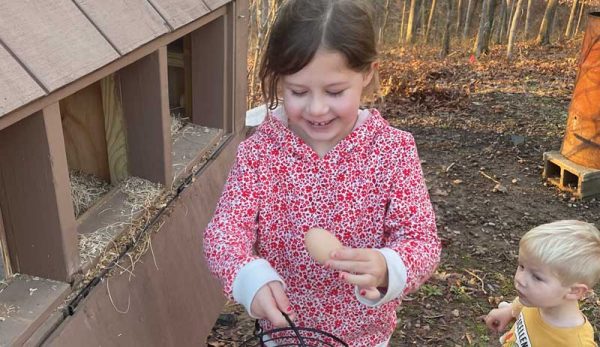
My journey with chickens began when my husband and I moved out of suburbia and onto 6 tree-filled acres in rural Tennessee, mid-2021. After repurposing an old doghouse into a very nice chicken coop, we headed to the local farm-supply store and came home with six Easter Egger pullets. My granddaughter carefully named member of the new chicken flock: Brownie, Cherrybit, Elfaba, Graybeard, Littlefoot and Penelope.
After eight weeks in the garage, we introduced the flock into our beautiful condominium of a chicken coop and anxiously waited for eggs! After carefully guarding and coddling them, we slowly let them free-range.
On the first day, two mysteriously disappeared, and we realized we weren’t the best chicken parents. We didn’t let them out for another three weeks until we felt that letting them out for short periods during the day was safer.

Rookie Mistakes
I still remember our surprise when we got our first eggs in December of that year. We were told they wouldn’t lay eggs in the dead of winter, so imagine our excitement when we discovered our first beautiful blue and brown eggs around Christmas at the age of 26 weeks.
The following spring, I headed back to the local store and picked up four more pullets. I also couldn’t resist the baby ducklings in a tub nearby. That was certainly a mistake! The two Peking ducks were adorable but quickly grew fat and really didn’t fit into the chicken coop world.
They were huge and also made a huge mess in the coop. They waddled, honked and really weren’t very nice, although they seemed to think they were part of the chicken family!
Our egg production plummeted, and after two months, I was ready to relocate the ducks to a nearby farm with a pond. They immediately took to the water, and I realized they were in a much better place. Afterwards, some normalcy returned to our coop!
Meanwhile, we needed more chickens, and the egg production was not going well. I found someone selling 12-week-old pullets at a nearby farm and came home with seven young hens and a rooster for our chicken flock! Our coop was flourishing.We were really feeling like irresponsible chicken owners by now, but we were determined to make a happy and safe place for our chickens. We lined the coop with a second layer of wire which we hoped would raccoon-proof the outside. During this time, we also trapped and relocated two raccoons that were stalking the place every night (caught on our trail cam). They would open the food-can lids and pretty much terrorized our chickens at night. I felt like this really contributed to the poor egg production, plus we kept finding shell-less eggs.
After relocating the food, we set about trying to solve the rubber egg problem. We always provided crushed oyster shell, but our chickens weren’t too interested. This is when we decided to introduce the shells of the few eggs we were getting into their diet. We would dry the shells overnight, pulverize them in a mortar and pestle, and then sprinkle this in their food every day. It seemed to do the trick, as over the next couple of weeks, the shell-less egg phenomenon subsided!

Time for More
We have lost many chickens over the last two years due to encounters with foxes, raccoons, unknown predators and illness, but our chickens are happiest when they can free-range. Hopefully our rooster, dogs and cats will keep them safe and happy enough to keep giving us eggs.
What a fun and egg-citing adventure keeping chickens has been. We can’t wait to see where this takes us. Having a rooster has gotten us into the business of hatching our own eggs. Out of six incubated, five eggs have hatched. We already have plans underway to enlarge our coop and improve our run for our expanded family of chickens to safely free-range.
Life with chickens has lots of ups and downs, but overall, we recommend it to anyone who has patience and time. While it has been a learning curve, we know we have so much more to learn!
Alison Davis is a retired medical technologist, mother
of four and “Nana” to three grandchildren. She and her husband recently moved from Nashville, Tennessee, to 6 acres nestled on a ridge in Kingston Springs, Tennessee, where they enjoy tending their garden, orchard, chickens and dogs.
This article originally appeared in the September/Ocober 2023 issue of Chickens magazine. Have a great story about your flock? Email the story of your birds in ~750 words to chickens@chickensmagazine.com (subject line: Chicken Chat). Be sure to include high-resolution images of yourself, your chickens and/or your coop. The author of each issue’s published essay receives a prize from one of our ad partners. (See print magazine for rules. Sponsor: EG Media Investments LLC)




